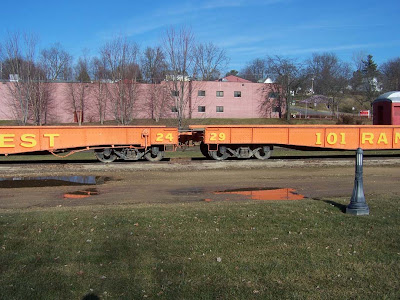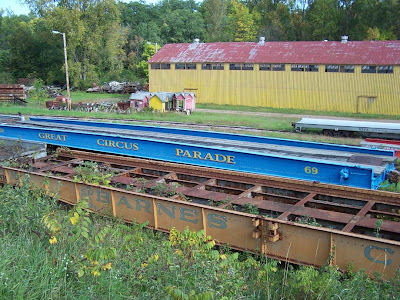 By BRIAN D. BRIDGEFORD/NEWS REPUBLIC
By BRIAN D. BRIDGEFORD/NEWS REPUBLICRock Springs resident Craig Janzen paints one of the colorfully-decorated, steel-rimmed wheels that will carry historic circus wagons through city streets July 12 when the Great Circus Parade returns to Milwaukee. He was working Thursday morning in the C. P. Fox Wagon Restoration Center of Circus World Museum. Visible behind him is the Pawnee Bill Bandwagon made in 1903.
Getting socked by June flooding interrupted rising attendance at Circus World Museum in 2008, the director said Thursday. However the museum can look forward to a successful Milwaukee Great Circus Parade in July and rising visitor numbers in 2010, he predicted.
CWM Executive Director Steve Freese met with members of the executive committee of the Circus World Museum Foundation, the non-profit organization that operates the museum on behalf of the State Historical Society of Wisconsin. They conducted a review of the shortfalls and successes of 2008 and looked forward to the next budget they must prepare, the one for 2010.
In 2007, visitors coming to Circus World Museum was rising for the first time in years and reached about 56,000 people, Freese said. Attendance was rising again in 2008, until the Baraboo River overtopped its banks in early June and forced the closure of the museum grounds.
CWM has been recovering from the floods and that trend should continue, Freese said.
"We'll be back on the growth we did in 2007, and up through the flood in 2008," he said. "We had 15 percent growth in 2007 in attendance, and we were up to 8 percent growth before the flood, That hit us pretty badly and we lost attendance," he said. Museum staff are working hard on the big project for the year, the parade through Milwaukee, Freese said. It will be the first since 2003.
CWM has already completed contracts with the horse teams and drivers who will be pulling the wagons, Freese said. Restoration of the historic circus wagons that will appear in the parade is also moving along well, he said.
In the C. P. Fox Wagon Restoration Center, Wagon Superintendent Harold "Heavy" Burdick and a crew of museum employees and volunteers were busy preparing 50 elaborately-carved and colorful circus wagons to make their best showing during the Great Circus Parade July 12 in Milwaukee.
On one side of the wagon workshop, Baraboo carpenter Jeff Fry used an electric saw and chisel to shape part of a wooden frame for the Ken Maynard Air Calliope Wagon. Time and again, he tried the fit of the part before taking it back to his workbench to shape it further.
The calliope wagon, a type of musical instrument circuses used to attract crowds, stood stripped to bare wood, waiting for completion of its restoration. Burdick flipped a sheet over and displayed the gleaming, brass pneumatic pipes of the wagon's music-making mechanism.
"It needs some loving," he said of the antique circus wagon.
In another area, Rock Springs resident Craig Janzen and Donald Sanders of Baraboo painted the colorful wood and steel-rimmed wheels that carry the wagons along the parade route. Overlooking them were the ornately painted scenes and faces of the museum's Pawnee Bill circus bandwagon, originally made in 1903 for Pawnee Bill's Wild West Show.
As part of preparations for the parade, Burdick said they had the wheels squeezed by a giant hydraulic machine to make sure the steel rims cling tight to the wooden spokes and hubs. Each wheel can weight up to several hundred pounds, he said. "That's 200 wheels, we have to make sure they go three miles (of the parade route)," he said.
Fry said the last six months of working on wagon restoration rather than home building has been a new experience for him. "You get to use the same skills," but it's always interesting here," he said. "You never know what they'll pull in here." Fry added it is a lot better to be working in a heated workshop rather than an outdoors construction site.
On another side of the workshop near giant garage-type doors a second air calliope wagon stood, the Cole Brothers Air Calliope No. 82, ready to take part in the parade. This one gleamed with a new coat of red paint and looked as if it was ready for work almost a century ago in the golden age of circuses, parading through the streets to draw adults and children to the performances under the big top. "That was a total restoration too," Burdick said. "It worked out really nice.
"A compliment to my guys, because I couldn't do it without them," he said. "They deserve a lot of credit for what they do here."
Burdick said he expects he and his co-workers will not be done restoring all the wagons until shortly before the Great Circus Parade hits Milwaukee's streets this summer.
In the CWM conference room, Freese said he is optimistic about the future of the museum. However, with the economic slowdown, he didn't expect attendance in 2009 to rise above that of last year, about 53,000 people.
But as the economy revitalizes in 2010, Freese said effective efforts to promote the museum will again bring rising numbers of visitors. His strategy has been to be "really out there with the public." "I think because of the different marketing style and approach that I've taken to the management of the facility, I think we can reasonably expect an uptick in the attendance," Freese said. "We have basically two-and-a-half years evidence for that."


















































